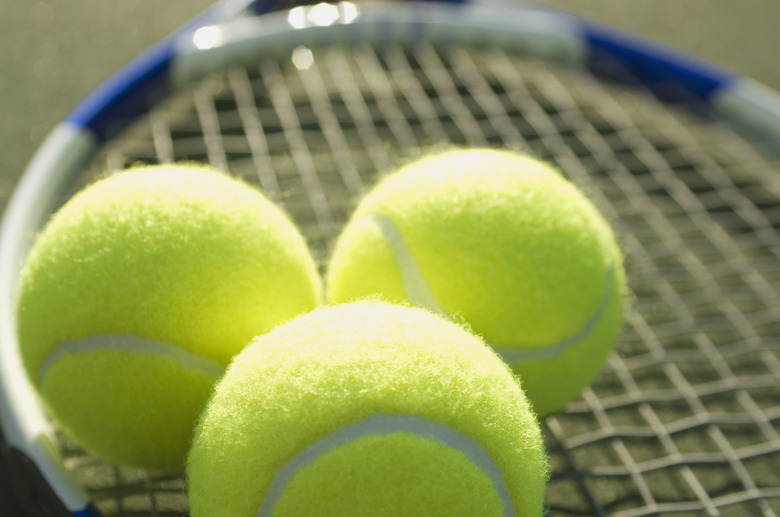Science Experiments With Tennis Balls
The fuzzy green tennis ball of today looks a lot different than its predecessors. The original tennis balls were made of leather and stuffed with wool or fur. Though the balls look different, tennis as a sport was, and is, all about the physics. Modern tennis balls can be used in a variety of experiments that examine the factors that impact how the balls bounce.
Kinetic Energy Experiment
Kinetic Energy Experiment
Tennis balls can be used in conjunction with larger sports balls to demonstrate the principle of kinetic energy, or how energy can be transferred between objects. Students hold a tennis ball on top of a basketball and drop them simultaneously from a window or platform. If the positioning is done correctly, the basketball will hit the ground first and bounce back into the tennis ball, sending the smaller ball flying high into the air. The student can do multiple drops with other sports balls and record which type of ball transferred the most energy into the tennis ball based on how far the tennis ball flew.
Temperature Experiment
Temperature Experiment
Tennis balls can be used for an experiment that examines the affect temperature has on matter. Students start by measuring how high a room temperature tennis ball bounces when dropped from a certain height. Then a different tennis ball that has been chilled in a freezer for several hours is bounced, followed by a tennis ball that has been wrapped in a heating pad. The temperatures of each ball are recorded before bouncing. Once all the data is collected and recorded, students can research why the balls performed as they did.
Durability Experiment
Durability Experiment
Another science experiment for tennis balls involves testing balls of a certain age against one another. Students gather balls that have been used in 10, 20, 50 or 100 games and measure how high they bounce compared to a brand new tennis ball. Students chart the performance of each ball using a bounce ratio. The bounce ratio is obtained by dividing the height the ball bounces to by the height it was dropped from.
Hardness Experiment
Hardness Experiment
In this experiment, students are testing how the hardness of rubber impacts a tennis ball's performance. Students must first research the differences between the brands of tennis balls and select a range of them to test. The balls are numbered and undergo two tests. In the first test, students measure how high each ball bounces when dropped from a specific height. The second test measures how far the balls travel when shot out of a tennis ball launcher. Students analyze the data to determine what, if any, affect hardness has on the performance of a tennis ball.
Cite This Article
MLA
Mozuch, Mo. "Science Experiments With Tennis Balls" sciencing.com, https://www.sciencing.com/science-experiments-with-tennis-balls-12750900/. 20 September 2011.
APA
Mozuch, Mo. (2011, September 20). Science Experiments With Tennis Balls. sciencing.com. Retrieved from https://www.sciencing.com/science-experiments-with-tennis-balls-12750900/
Chicago
Mozuch, Mo. Science Experiments With Tennis Balls last modified August 30, 2022. https://www.sciencing.com/science-experiments-with-tennis-balls-12750900/
